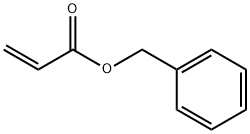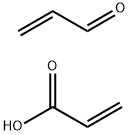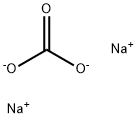Sodium acrylate
Synonym(s):Acrylic acid sodium salt
- CAS NO.:7446-81-3
- Empirical Formula: C3H3NaO2
- Molecular Weight: 94.04
- MDL number: MFCD00067207
- EINECS: 231-209-7
- SAFETY DATA SHEET (SDS)
- Update Date: 2024-12-18 14:15:30

What is Sodium acrylate?
Chemical properties
Colorless or light yellow viscous liquid, non-toxic, weakly alkaline, insoluble in organic solvents such as ethanol, acetone, etc., easily soluble in water and aqueous sodium hydroxide, but in aqueous solutions such as calcium hydroxide, magnesium hydroxide, etc., with the increase in the number of alkaline-earth metal ions, the first to dissolve and then precipitate.
The Uses of Sodium acrylate
Sodium Acrylate (SA) is a sodium salt of acrylic acid with antibacterial properties. Sodium polyacrylate is a sodium salt of a polymer consisting of acrylic acid, methacrylic acid or one of their simple esters. SA can be used in tuning the grain size of iron oxide microparticles for potential applications in biological assaying and in chemical sensors. Additionally, it acts as a reducing and capping agent for gold nanoparticles, beneficial for various biological applications.
The Uses of Sodium acrylate
Sodium Acrylate is the acid form of Acrylic Acid (A191350); which is an antibacterial agent.
General Description
Sodium acrylate (SA) is a metal salt that can be prepared by an acid-base reaction between sodium hydroxide and acrylic acid. It can be used in the preparation of poly(sodium acrylate) using bulk, solution, emulsion, and suspension polymerization techniques. It results in the formation of a water soluble polymer that can be used in a variety of industries and personal care applications.
Flammability and Explosibility
Non flammable
Synthesis
An aqueous solution of sodium acrylate is prepared from 216.2 g of acrylic acid (100%=3 mol), 262.8 g of NaOH (50%) and 497 g of water. 3.7 g of N-nitrosodiphenylamine and 3.7 g of 4-methoxyphenol are added to stabilize the solution. 12 g of the quaternary ammonium salt used in Example 1 are also added. 1,125 g (9 mol) of 1,4-dichlorobutene are run in at 90° C. 15.9 g of Na2CO3 are added after 1 hour and the mixture is left to react for a further 2 hours at 90° C. After phase separation, the organic layer is distilled under vacuum. 286.0 g (1.78 mol) of 4-chloro-2-butenyl acrylate (59.4% of the theoretical yield) are obtained. 641 g (5.13 mol) of dichlorobutene are recovered.
References
[1] SIMONE MANZINI . Palladium- and Nickel-Catalyzed Synthesis of Sodium Acrylate from Ethylene, CO2, and Phenolate Bases: Optimization of the Catalytic System for a Potential Process[J]. European Journal of Organic Chemistry, 2015, 2015 32: Pages 7122-7130. DOI:10.1002/ejoc.201501113.
[2] KALRA B, GROSS R A. HRP-mediated polymerizations of acrylamide and sodium acrylate[J]. Green Chemistry, 2002, 2: 174-178. DOI:10.1039/B106735B.
[3] https://www.ewg.org/skindeep/ingredients/705976-SODIUM_ACRYLATES_COPOLYMER/
Properties of Sodium acrylate
| Melting point: | >300 °C (lit.) |
| Density | 1.528[at 20℃] |
| storage temp. | under inert gas (nitrogen or Argon) at 2-8°C |
| solubility | Aqueous Acid (Slightly), Methanol (Slightly), Water (Slightly) |
| form | Solid |
| color | White to Off-White |
| Water Solubility | 479g/L at 20℃ |
| Hydrolytic Sensitivity | 0: forms stable aqueous solutions |
| Stability: | May be unstable; may spontaneously polymerize. Incompatible with strong oxidizing agents. |
| CAS DataBase Reference | 7446-81-3(CAS DataBase Reference) |
| EPA Substance Registry System | Sodium acrylate (7446-81-3) |
Safety information for Sodium acrylate
| Signal word | Warning |
| Pictogram(s) |
 Environment GHS09 |
| GHS Hazard Statements |
H400:Hazardous to the aquatic environment, acute hazard |
| Precautionary Statement Codes |
P273:Avoid release to the environment. P391:Collect spillage. Hazardous to the aquatic environment P501:Dispose of contents/container to..… |
Computed Descriptors for Sodium acrylate
New Products
Tert-butyl bis(2-chloroethyl)carbamate 4-Methylphenylacetic acid N-Boc-D-alaninol N-BOC-D/L-ALANINOL 3-Morpholino-1-(4-nitrophenyl)-5,6-dihydropyridin- 2(1H)-one Furan-2,5-Dicarboxylic Acid Tropic acid 1,1’-CARBONYLDIIMIDAZOLE DIETHYL AMINOMALONATE HYDROCHLORIDE R-2-BENZYLOXY PROPIONIC ACID 1,1’-CARBONYLDI (1,2-4 TRIAZOLE) N-METHYL INDAZOLE-3-CARBOXYLIC ACID (2-Hydroxyphenyl)acetonitrile 4-Bromopyrazole 5-BROMO-2CYANO PYRIDINE 5,6-Dimethoxyindanone 5-broMo-2-chloro-N-cyclopentylpyriMidin-4-aMine 2-(Cyanocyclohexyl)acetic acid 4-methoxy-3,5-dinitropyridine 2-aminopropyl benzoate hydrochloride 1-(4-(aminomethyl)benzyl)urea hydrochloride diethyl 2-(2-((tertbutoxycarbonyl)amino) ethyl)malonate tert-butyl 4- (ureidomethyl)benzylcarbamate Ethyl-2-chloro((4-methoxyphenyl)hydrazono)acetateRelated products of tetrahydrofuran








You may like
-
 Sodium acrylate 98% CAS 7446-81-3View Details
Sodium acrylate 98% CAS 7446-81-3View Details
7446-81-3 -
 Sodium acrylate 98.00% CAS 7446-81-3View Details
Sodium acrylate 98.00% CAS 7446-81-3View Details
7446-81-3 -
 Sodium acrylate CAS 7446-81-3View Details
Sodium acrylate CAS 7446-81-3View Details
7446-81-3 -
 1975-50-4 98%View Details
1975-50-4 98%View Details
1975-50-4 -
 2-HYDROXY BENZYL ALCOHOL 98%View Details
2-HYDROXY BENZYL ALCOHOL 98%View Details
90-01-7 -
 14714-50-2 (2-Hydroxyphenyl)acetonitrile 98+View Details
14714-50-2 (2-Hydroxyphenyl)acetonitrile 98+View Details
14714-50-2 -
 118753-70-1 98+View Details
118753-70-1 98+View Details
118753-70-1 -
 733039-20-8 5-broMo-2-chloro-N-cyclopentylpyriMidin-4-aMine 98+View Details
733039-20-8 5-broMo-2-chloro-N-cyclopentylpyriMidin-4-aMine 98+View Details
733039-20-8